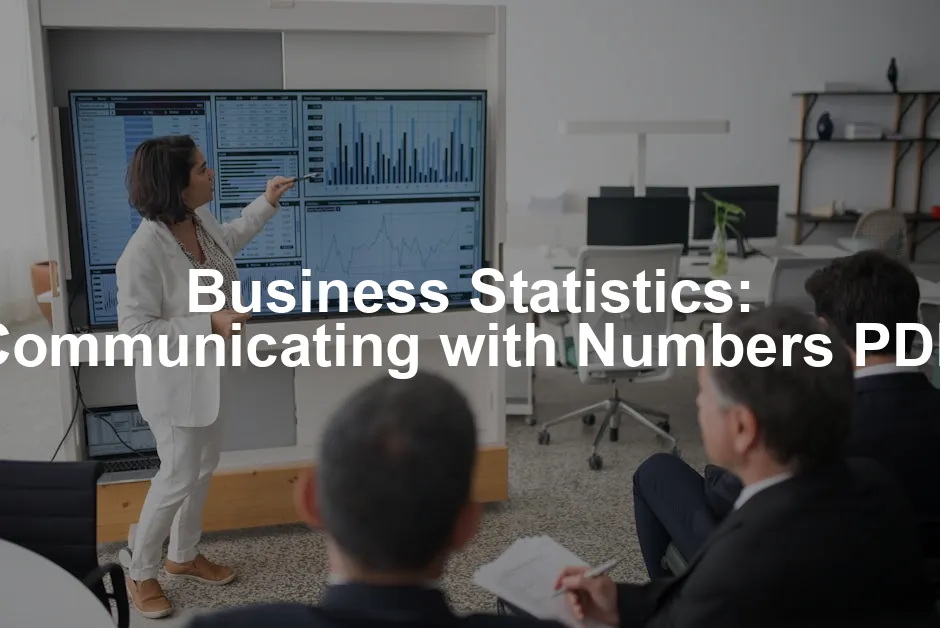Introduction
In the fast-paced world of business, numbers tell stories. They guide decisions, reveal trends, and forecast future possibilities. Business statistics play a crucial role in helping organizations make informed choices. Whether you’re a startup or a multinational corporation, understanding statistics can mean the difference between thriving and just surviving.
This article focuses on the PDF version of “Business Statistics: Communicating with Numbers” by Sanjiv Jaggia. This book has gained recognition for its accessible approach to complex statistical concepts. It serves as a valuable resource for students and professionals alike. By breaking down intricate ideas, it empowers readers to harness the power of data.
Why is it essential to communicate statistical data effectively? Well, imagine presenting data to your team. If they don’t grasp the significance, your hard work is in vain. Effective communication ensures that insights translate into actions. This book emphasizes clear, concise representation of statistical findings, making it easier for readers to absorb and apply the information.
Statistics are not just about crunching numbers; they’re about storytelling through data. This article will unpack the key elements of business statistics, showcasing how they influence decision-making in various contexts. We’ll highlight the importance of this textbook in cultivating your statistical literacy.

What are Business Statistics?
Definition and Importance
Business statistics is a branch of applied mathematics. It focuses on collecting, analyzing, and interpreting data relevant to business. This field is pivotal for business analytics, allowing companies to make data-driven decisions. The role of statistics transcends mere number-crunching; it involves strategic insight.
In today’s data-driven world, decision-making relies heavily on statistical analysis. Why? Because data provides a clearer picture of market trends, customer preferences, and overall performance. Businesses that leverage statistics can identify opportunities and mitigate risks effectively. Without this knowledge, companies may flounder in a sea of uncertainty.
If you’re looking to get a solid foundation in statistics, consider picking up Probability and Statistics for Dummies. This book is perfect for beginners and offers a humorous take on the subject, making learning less daunting.

Key Concepts in Business Statistics
Understanding business statistics requires familiarity with several key concepts. Let’s break them down:
- Descriptive Statistics: This involves summarizing and presenting data in a meaningful way. For instance, charts and graphs can reveal patterns at a glance. Imagine presenting quarterly sales data. A colorful pie chart can communicate performance better than a spreadsheet full of numbers.
- Inferential Statistics: This branch allows businesses to make predictions about a population based on sample data. For example, a company might survey a small group of customers to draw conclusions about the entire market. This method is crucial for testing hypotheses and making forecasts.
- Probability: Understanding probability helps businesses assess risks. It quantifies the likelihood of events occurring. Say a company is launching a new product. By analyzing market probabilities, they can decide whether to proceed or hold back.
These concepts are not just theoretical; they have real-world applications. For instance, a marketing team might use descriptive statistics to evaluate campaign performance. They can analyze customer engagement metrics and adjust their strategies accordingly. Similarly, finance teams employ inferential statistics to project revenues and expenses, allowing for better budget management.
To visualize and analyze data effectively, consider using a Graphing Calculator. It’s an essential tool for students and professionals who need to perform complex calculations with ease.

Overview of “Business Statistics: Communicating with Numbers”
Authors and Editions
Sanjiv Jaggia and Alison Kelly are the dynamic duo behind “Business Statistics: Communicating with Numbers.” Jaggia, a professor of Economics and Finance, calls California Polytechnic State University home. With a Ph.D. from Indiana University, he’s a Chartered Financial Analyst (CFA®). His research interests span statistics and data analytics, and he has co-authored multiple textbooks. When he’s not shaping future statisticians, you can find him cooking up a storm or hiking through nature.
Alison Kelly, on the other hand, is a seasoned professor of Economics at Suffolk University. She earned her Ph.D. from Boston College and, like Jaggia, holds CFA® certification. Her expertise lies in applied statistics and econometrics. Alison also lends her talents as a consultant, helping companies navigate the complexities of Dodd-Frank Act compliance. Outside academia, she enjoys staying active and tending to her garden.
This textbook has evolved through several editions, each enhancing its practical approach. The latest, the 4th Edition, published in 2022, reflects contemporary business needs and analytics. Each iteration has adapted to changes in statistical methods and educational techniques, ensuring that it remains relevant and user-friendly.
To dive deeper into statistical methods, consider checking out The Essentials of Business Statistics. It provides a concise overview of the fundamental concepts that are crucial for effective analysis.

Key Features of the Book
“Business Statistics: Communicating with Numbers” stands out for its user-friendly approach to complex statistical methods. This book doesn’t just throw numbers at you; it offers a roadmap through the statistical jungle. It emphasizes practical examples, allowing readers to see how statistics apply in real-world scenarios.
The organization of the book is another highlight. It breaks down intricate concepts into digestible chunks. Readers can easily navigate through topics, starting from basic principles to more advanced statistical techniques. Each chapter not only introduces essential concepts but also illustrates their application in the business realm.
The book includes a variety of visual aids, making it easier to grasp complex ideas. With engaging graphics, tables, and real-life examples, readers can visualize data rather than merely crunching numbers. This focus on effective communication through numbers elevates the learning experience, ensuring that readers can apply what they learn in practical settings.
For those interested in enhancing their data visualization skills, check out Data Visualization Tools. They can help you present your findings in a compelling manner!

Content Breakdown: Chapters and Topics
Introduction to Business Statistics
The initial chapters serve as a solid foundation for understanding business statistics. They cover essential topics such as data collection and preparation. Readers will learn how to gather relevant data, ensuring that their analyses are built on a strong base. The importance of data integrity cannot be overstated—it’s the lifeblood of any statistical analysis.
These chapters also introduce key statistical concepts. They guide readers through the process of cleaning and organizing data, preparing them for deeper statistical exploration. By establishing a thorough understanding of data, readers will be better equipped to tackle more complex statistical techniques later on.
For those looking to enhance their Excel skills, consider grabbing Microsoft Excel. It’s an essential tool for data analysis and visualization, making it easier to manage your statistical projects.

Descriptive Statistics
Descriptive statistics play a significant role in summarizing and presenting data effectively. This section delves into tabular and graphical methods, showcasing how these tools can communicate information clearly. Readers will discover the power of numerical descriptive measures, transforming raw data into meaningful insights.
Visualizing data is crucial in business contexts. A well-constructed graph can tell a story that numbers alone cannot convey. The book emphasizes the importance of using visuals to communicate findings, making it easier for stakeholders to understand trends and patterns. Whether it’s pie charts, bar graphs, or histograms, each visualization serves a purpose in highlighting business insights.
Understanding descriptive statistics equips readers with the skills to analyze data sets and derive actionable conclusions. As businesses increasingly rely on data-driven decisions, mastering these concepts becomes vital for success. The book ensures that readers not only learn the theory but also the practical application of descriptive statistics in real-world scenarios.
If you’re looking for a comprehensive resource, check out The Art of Statistics: Learning from Data. This book provides insights into the practical application of statistics in real-world scenarios.

With a blend of humor and clarity, “Business Statistics: Communicating with Numbers” lays the groundwork for effective statistical analysis, preparing readers for the complexities that lie ahead. By the end of this section, you’ll be ready to tackle business statistics with confidence and flair!
Probability Concepts
Probability is the backbone of business statistics. It helps businesses assess risks and make informed decisions. Understanding basic probability concepts is essential. These include outcomes, events, and the likelihood of occurrences.
For instance, consider a company launching a new product. By calculating the probability of success based on market research, they can make informed choices. It’s not just about launching; it’s about maximizing the chances of success.
Now, let’s talk about distributions. Probability distributions categorize outcomes based on their nature. There are two main types: discrete and continuous.
Discrete probability distributions deal with distinct outcomes. Think of rolling a die. You can predict the outcome of a single roll. Each number has an equal chance of appearing. On the other hand, continuous probability distributions cover an entire range of outcomes. They’re useful when dealing with measurements, such as heights or weights.
In business, understanding these distributions allows for better risk management and forecasting. By analyzing past data, companies can predict future trends and make data-driven decisions. For more on this topic, check out Data Science for Business. It’s a fantastic resource to understand how data can drive decision-making.

Understanding probability is essential for assessing risks in business. Mendelian Genetics Probability Pedigrees and Chi-Square Statistics offers a comprehensive guide to these concepts.
Inferential Statistics
Inferential statistics take sampling to the next level. It allows businesses to make predictions about a larger population based on a smaller sample. This is crucial for effective decision-making.
Sampling involves selecting a group from a larger population. For example, a restaurant might survey 100 customers to gauge satisfaction. This sample helps them infer the overall happiness of all their patrons.
Hypothesis testing plays a significant role here. It’s a method used to test assumptions. Businesses can determine if a new marketing strategy is effective or if a change in product design is worthwhile. For more insights on hypothesis testing, see Statistics Hypothesis Testing Cheat Sheet.

Advanced Topics
Let’s now venture into the advanced realm of business statistics. Here, we find powerful tools like regression analysis, statistical quality control, and time series analysis.
Regression analysis is a statistical technique that explores relationships between variables. Businesses use it to understand how changes in one factor affect another. For example, a retailer might analyze how advertising spend impacts sales. This insight allows them to allocate resources effectively.
Statistical quality control (SQC) helps maintain product quality. It uses statistical methods to monitor and control processes. For instance, a manufacturing company may use SQC to ensure that products meet quality standards. If defects arise, they can quickly identify and rectify the issue.
Time series analysis focuses on data points collected over time. Businesses use it to analyze trends and forecast future values. For example, a hotel might track occupancy rates over several years. This data helps them anticipate demand and optimize pricing strategies. To learn more about this method, visit Forecasting Trends in Manufacturing with Time Series Analysis.

Time series analysis is vital for forecasting trends. Forecasting Trends in Manufacturing with Time Series Analysis offers insights into this important technique.
How to Access “Business Statistics: Communicating with Numbers PDF”
Availability
Finding the PDF version of “Business Statistics: Communicating with Numbers” by Sanjiv Jaggia can be quite straightforward. Several online platforms offer this textbook, ensuring that students and professionals can easily access it.
Firstly, sites like Scribd and McGraw Hill provide digital copies for rental or purchase. Scribd also allows users to read for free for a limited time. If you prefer a more permanent solution, the McGraw Hill site lists options for both eBook and print formats. Prices vary, so it’s a good idea to compare before making a decision.
For those who are budget-conscious, library access can be a lifesaver. Many university libraries stock this textbook. You can either check it out in print or access the digital version through your library’s resources.
Moreover, platforms like Amazon and various academic book retailers offer the textbook in different formats. Always check for any available discounts or special offers, as prices can fluctuate.

Lastly, consider reaching out in online communities or forums. Users often share leads on where to find textbooks, including digital versions.
Tips for Effective Use
Studying statistical concepts can seem challenging, but a few strategies can enhance your learning experience.
- First, engage actively with the material. Don’t just read passively; take notes and summarize key points in your own words. This practice reinforces understanding.
- Second, apply what you learn. Use real-world data to practice statistical analysis. Whether you’re analyzing customer sales data or employee performance metrics, applying concepts helps solidify your knowledge.
- Third, make use of visual aids. Graphs and charts can make complex data more digestible. Create your own visuals to better understand the relationships between different variables.
- Fourth, join study groups. Discussing concepts with peers can provide new insights and enhance your understanding.
- Lastly, leverage online resources. Many websites and platforms offer additional tutorials and exercises related to business statistics. These can supplement your learning and provide varied perspectives on the same concepts.

By combining these strategies, you’ll be well-equipped to master the content of “Business Statistics: Communicating with Numbers” and apply statistical concepts effectively in your business practice.
Conclusion
Business statistics is more than just numbers; it’s a powerful tool for informed decision-making. In our rapidly changing business environment, understanding how to interpret data is crucial. Whether you’re analyzing sales trends or assessing market risks, effective communication through statistics can make or break your strategy.
This textbook, “Business Statistics: Communicating with Numbers,” is a stellar resource. It simplifies complex ideas and equips readers with the skills to communicate effectively using data. By mastering these concepts, you can transform chaotic numbers into actionable insights. This skill is invaluable, as it allows you to convey your findings clearly, ensuring that your team and stakeholders understand the implications.
Don’t underestimate the power of this book! It’s designed to engage readers and encourage them to think critically about data. By exploring the textbook, you’ll gain a deeper understanding of key statistical concepts and their practical applications in real-world business scenarios.
So, if you’re eager to enhance your statistical literacy, dive into this resource! Unlock the potential of data-driven decision-making, and watch your business flourish as you harness the power of numbers. And don’t forget to check out Statistical Analysis Software for all your data analysis needs!

FAQs
What is the main goal of business statistics?
The primary goal of business statistics is to aid in data-driven decision-making. It provides the tools and techniques necessary for analyzing data effectively. With these methods, businesses can draw meaningful conclusions from raw data, allowing them to make informed choices.
How can I apply the concepts learned from this textbook?
The concepts learned from “Business Statistics: Communicating with Numbers” can be applied across various business domains. In marketing, for example, you can analyze consumer behavior and campaign performance. By understanding customer preferences through data, marketing strategies can be tailored to meet these needs effectively.
Is the PDF version of the textbook different from the print version?
The PDF version of “Business Statistics: Communicating with Numbers” may differ from the print version in layout and accessibility. While the content remains consistent, the digital format often allows for easier navigation through hyperlinks and search features, enhancing user experience.
Where can I find additional resources for learning business statistics?
There are plenty of resources available for learning business statistics beyond the textbook. Online platforms like Coursera and edX offer courses tailored to statistics and data analysis. Websites such as Khan Academy provide free tutorials on fundamental concepts.
Please let us know what you think about our content by leaving a comment down below!
Thank you for reading till here 🙂
All images from Pexels




